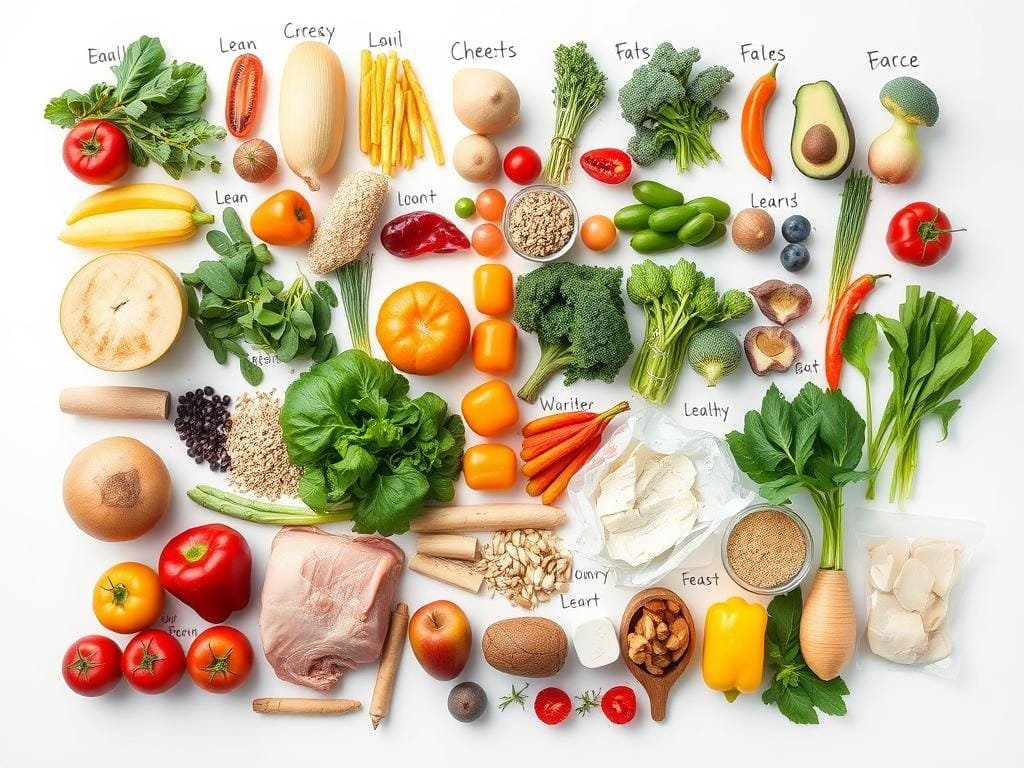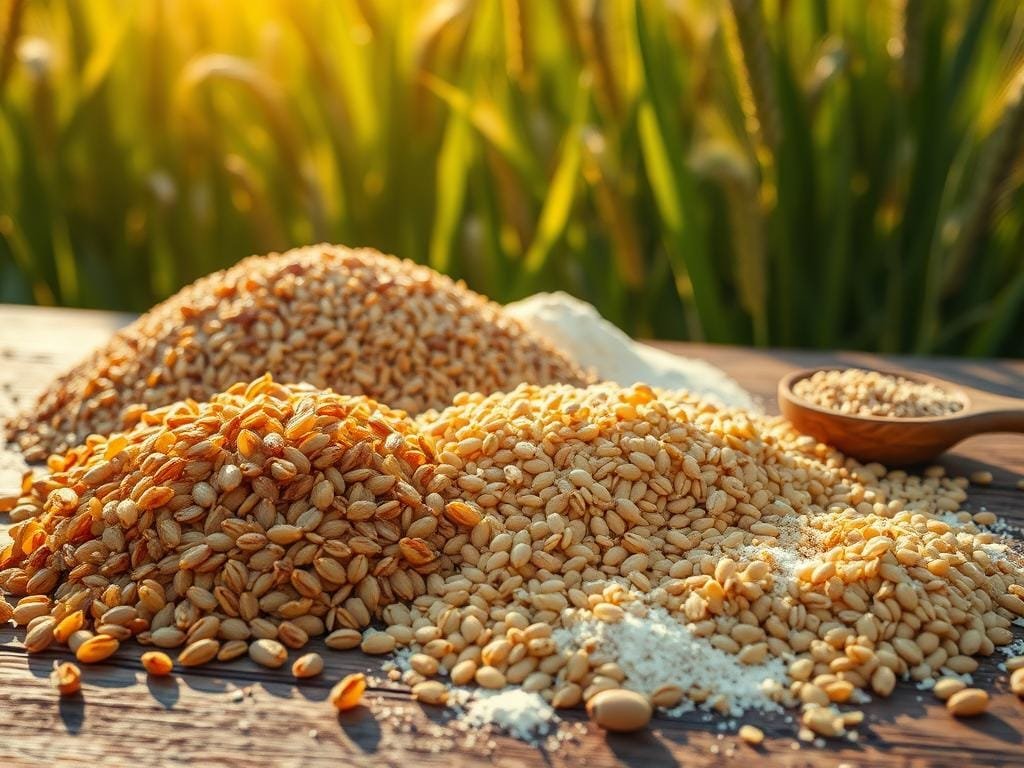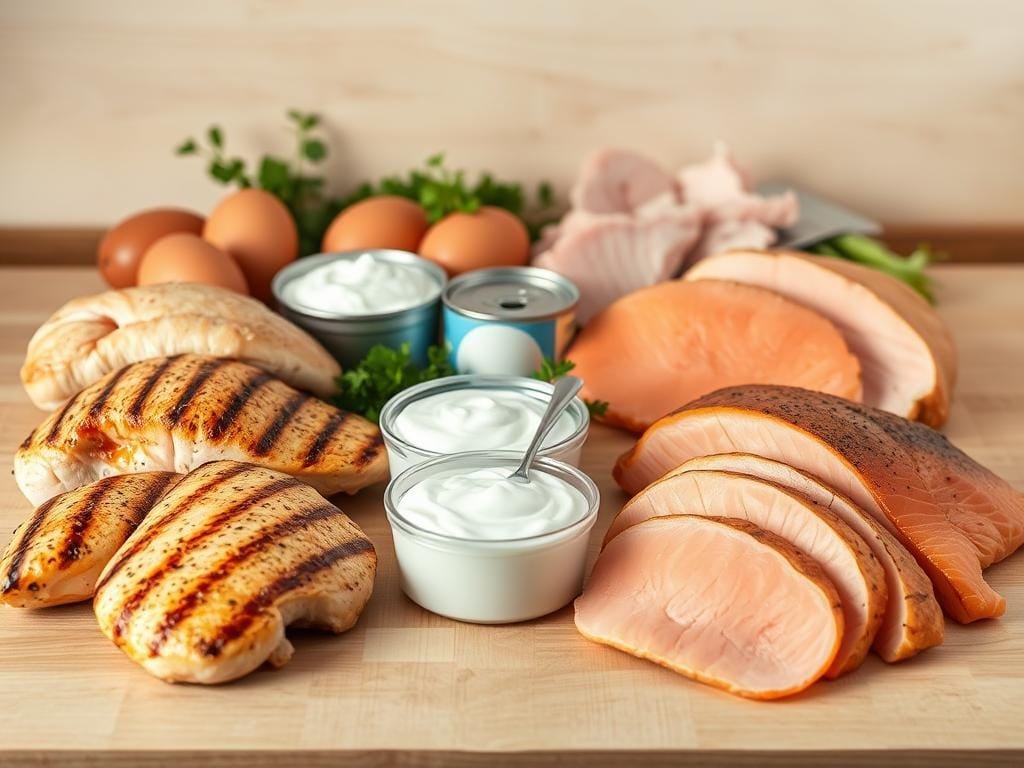Did you know a well-stocked kitchen is key to healthy eating? The right ingredients help you cook nutritious meals and avoid unhealthy choices. A beginner’s guide to healthy shopping is the first step to a healthy kitchen.
We’ve put together a detailed healthy grocery list for you. It includes everything from fresh produce to pantry staples. This guide helps you make smart choices at the store.
We’ve also made a printable guide for your next shopping trip. Follow this guide to stock a kitchen that supports your health and wellness goals.
Table of Contents
Why a Healthy Grocery List is Important for You
Knowing the value of a healthy grocery list can greatly improve your health. It lets you make choices that are good for you and your budget. By planning your shopping, you can pick the best foods for a balanced diet.
Benefits of Planning Your Grocery List
Planning your list helps you make smart shopping choices. It cuts down on food waste and saves money. It’s a simple way to make sure you buy the right foods for a healthy diet. With a list, you’re less likely to buy unhealthy foods on impulse.
How It Supports Healthy Eating Habits
A well-planned list supports healthy eating habits. It makes sure your pantry and fridge have nutritious foods. This makes it easier to cook healthy meals and avoid unhealthy choices. For more tips, visit Healthier Grocery Shopping.
Saving Time and Money with Your List
Having a list saves money by cutting down on impulse buys and food waste. It also saves time when you shop. You can find what you need quickly, making shopping more efficient. To make healthy eating a part of your life, check out How to Make Eating Healthy a lifestyle.
Essential Food Categories to Include
A good basic healthy shopping list should have different food groups. This ensures you get all the nutrients your body needs. It’s important to focus on key categories for a healthy diet.
Fresh Fruits and Vegetables
Fresh fruits and veggies are key for a healthy diet. They give you important vitamins, minerals, and antioxidants. Try to pick different colors to get a wide range of nutrients. For more tips, visit https://boosthealthylife.com/ideal-diet-for-a-healthy-lifestyle/.

Whole Grains and Legumes
Whole grains and legumes are full of fiber, vitamins, and minerals. They are essential for a novice healthy eating grocery list. Grains like brown rice and quinoa give you energy. Beans and lentils are great for protein and fiber.
Lean Proteins and Dairy Options
Lean proteins and dairy are important for muscle health and feeling full. Choose lean meats, fish, and plant-based options. Also, include dairy or fortified plant-based milk for calcium and protein.
By focusing on these food categories, you can make a balanced grocery list. This supports your health and well-being.
Fresh Fruits and Vegetables to Stock Up On
Fresh fruits and vegetables are key to a healthy diet. They add important nutrients and flavor to your meals. Keeping a good stock of these items helps you eat well.
Seasonal Produce to Consider
It’s smart to include seasonal produce in your grocery list. It’s fresher, tastes better, and saves money. For example, summer brings berries, tomatoes, and cucumbers. Winter offers carrots and sweet potatoes.
For more healthy food ideas, check out Forks Over Knives. They have a detailed list of healthy options.
Tips for Choosing Organic vs. Conventional
Choosing between organic and conventional produce can be tough. Organic is grown without pesticides but costs more. Here are some tips:
- Choose organic for produce with high pesticide residue, like strawberries and spinach.
- Opt for conventional for produce with lower pesticide residue, such as avocados and pineapples.
- Consider buying locally sourced produce to support your community and reduce environmental impact.
Storage and Preparation Tips
Proper storage and preparation keep fruits and vegetables fresh. Here are some tips:
| Produce | Storage Tips | Preparation Tips |
|---|---|---|
| Apples | Store in the refrigerator to keep fresh. | Wash before slicing or eating. |
| Carrots | Keep in a cool, dry place or refrigerate. | Peel and chop for snacking or cooking. |
| Berries | Refrigerate and use within a few days. | Rinse gently before eating or using in recipes. |
By following these tips, you can make a balanced grocery list. This will help you eat healthy and enjoy a variety of fresh fruits and vegetables.
Whole Grains: A Key Component of Your Diet
Whole grains are more than just a healthy option; they’re a key component of a balanced diet that boosts your well-being. Adding a variety of whole grains to your meals gives you essential nutrients, fiber, and energy.

Popular Whole Grains to Include
Brown rice, quinoa, whole wheat, and oats are some of the most nutritious whole grains. They are packed with fiber, vitamins, and minerals. For instance, quinoa is a complete protein, great for vegetarians and vegans. Learn more about whole grains at Mayo Clinic.
Different Ways to Prepare Whole Grains
It’s easy and fun to prepare whole grains. You can boil, steam, or bake them. Brown rice can be boiled or cooked in a rice cooker. Quinoa can be steamed or sautéed with veggies. Oats are great for oatmeal or baking. Try different recipes to find your favorite ways to add whole grains to your beginner meal prep grocery list.
Understanding Labels: Whole Grain vs. Refined
When buying whole grains, know the difference between whole grain and refined products. Whole grains have the entire kernel, giving you more fiber and nutrients. Refined grains, lacking the bran and germ, offer mostly empty calories. Always check labels for the nutritional benefits of whole grains. For a basic healthy shopping list, look for “100% whole grain” or “whole wheat” products.
By making whole grains a key part of your diet, you’re taking a big step towards healthier eating. For more tips on adding whole grains to your family’s diet, visit Boost Healthy Life for more resources.
Lean Proteins: Healthy Choices for Your Meals
Starting a healthy eating journey means learning about lean proteins. They are essential for a balanced diet and good health. Lean proteins give the body nutrients, help muscles grow, and aid in weight management.
Types of Lean Proteins to Purchase
There are many lean protein options. You can choose:
- Poultry like chicken and turkey breast
- Fish and seafood, such as salmon and shrimp
- Lean cuts of beef, like sirloin or tenderloin
- Legumes, including lentils and chickpeas
For a detailed list of high-protein foods, check out this high-protein grocery list. It helps you make better choices.
Plant-Based Protein Alternatives
Looking for plant-based protein options? There are many:
- Tofu and tempeh
- Seitan
- Plant-based protein powders
- Nuts and seeds, such as almonds and chia seeds

Tips for Cooking and Meal Prep
Cooking lean proteins is easy and tasty. Here are some tips:
- Grill or bake your proteins instead of frying them.
- Use herbs and spices to add flavor without extra salt or sugar.
- Prepare your meals in advance to save time during the week.
- Experiment with different marinades to enhance the taste of your proteins.
By following these tips, you can make many healthy and tasty meals.
Healthy Fats to Add to Your Grocery Cart
Healthy fats are key for a balanced diet. They help your heart and make you feel full. Adding the right healthy fats to your shopping list can make your meals better and improve your health.
Sources of Healthy Fats
When you’re shopping for healthy fats, make sure to pick these:
- Nuts and seeds, like almonds and chia seeds, are full of omega-3s.
- Avocados are packed with monounsaturated fats, good for your heart.
- Olive oil is great for cooking and dressings, with lots of health benefits.
- Fatty fish, such as salmon, are rich in omega-3s.
These foods add taste and variety to your meals. They also give you important nutrients.
Portion Control and Serving Suggestions
It’s important to control how much you eat of healthy fats. A handful of nuts is a serving size. Olive oil is a tablespoon. Avocados can be eaten in slices or as a spread. Knowing the right amounts helps you enjoy the benefits without too many calories.
For tips on meal planning and portion control, check out our article on simple meal plans for fat loss and energy.
Myths About Fats in Your Diet
Many people think all fats are bad. But, healthy fats are good for you. They help your brain work and help you absorb vitamins.
Debunking the myth: Not all fats are the same. While too much saturated and trans fat is bad, healthy fats in avocados and nuts are good.
Snacks and Convenience Foods That Are Healthy
Choosing healthy snacks can be tough, but it’s doable. You can fill your pantry with good options. As you make your easy beginner grocery lists, pick snacks that are both healthy and easy to grab.
Healthy Snack Ideas for Busy Days
It’s easy to grab unhealthy snacks when you’re in a rush. But, with some planning, you can have healthy snacks ready. Here are some ideas:
- Fresh fruits like apples, bananas, or berries
- Nuts and seeds, such as almonds or pumpkin seeds
- Energy bars made with wholesome ingredients
- Veggie sticks with hummus for a satisfying crunch
These snacks are not only good for you but also simple to add to your beginner meal prep grocery list.
Choosing Convenience Foods Wisely
While making meals from scratch is best, convenience foods can be helpful on hectic days. Look for convenience foods that are:
- Low in added sugars and sodium
- High in fiber and protein
- Made with wholesome ingredients
By picking wisely, you can enjoy convenience without hurting your health goals.
Homemade Snack Options
Making snacks at home lets you control what goes into them. Here are some easy ideas:
- Trail mix made with nuts, seeds, and dried fruits
- Homemade energy balls using oats, honey, and peanut butter
- Roasted chickpeas seasoned with herbs and spices
These snacks are great for your easy beginner grocery lists. You can also change them to fit your taste.
Adding these healthy snack ideas to your daily routine helps keep your diet balanced, even when you’re busy. A well-stocked pantry is key. Make sure to include a variety of snacks on your beginner meal prep grocery list.
Essential Pantry Staples for Healthy Cooking
A well-stocked pantry is the heart of a healthy kitchen. It lets you make nutritious meals easily. Having the right ingredients helps you cook healthy meals and avoid unhealthy takeouts or processed foods.
Must-Have Herbs and Spices
Herbs and spices add flavor to your meals without extra salt or sugar. You’ll need basil, oregano, and thyme for herbs. For spices, cumin, turmeric, and paprika are essential. They’re great for soups, stir-fries, and more.
Oils and Vinegars to Consider
Oils and vinegars are great for cooking, dressings, and marinades. Use olive oil, coconut oil, and avocado oil for cooking. Apple cider vinegar, balsamic vinegar, and white wine vinegar add flavor to salads and dishes.
Importance of Stocking Broth and Sauces
Broths and sauces are key for many recipes. They’re the base for soups, stews, and sauces. Keep low-sodium chicken, beef, and vegetable broth, along with tomato sauce and pesto, on hand. For more pantry tips, check out Martha Stewart’s guide on maintaining a perfect pantry.
| Pantry Staple | Usage | Health Benefit |
|---|---|---|
| Olive Oil | Cooking, Salad Dressings | Rich in Healthy Fats |
| Balsamic Vinegar | Salad Dressings, Marinades | Antioxidant Properties |
| Chicken Broth | Soups, Stews, Sauces | Low in Calories, Rich in Protein |
Adding these pantry staples to your kitchen helps you make healthy meals. A well-stocked pantry is essential for a basic healthy shopping list and supports your novice healthy eating grocery list goals.
Printable Grocery List: Your Handy Guide
Now that you know the key categories and items for a healthy list, it’s time to use our printable list. This guide makes shopping for healthy food easy, perfect for beginners.
Effective Use and Customization
Start by checking off items you buy often. You can find a detailed list on Allrecipes. It includes fruits, veggies, proteins, and pantry items. Tailor the list to fit your diet and needs.
Keeping Your List Updated
As you shop and cook, update your list. This keeps you on track with your healthy eating goals. You’ll always have the right ingredients.
With our printable list, you’ll become a pro at healthy shopping. Happy shopping!

